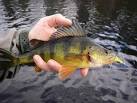
“Perch” Maynard was a long time guide on the New River before up and moving to South Carolina in order to battle redfish and speckled trout rather than smallmouth bass. “Perch” received his nickname from the legendary fly tier and fishing guide, Chuck Kraft.
Chuck teasingly told Maynard that when it came to fishing, he was little more than a perch jerker, and the name stuck. “Perch” wore it like a badge of honor, and well he should.
Personally, I’d rather go perch jerking than almost any other type of fishing. Why?
Well, here we are in mid-February. Hunting season is in the rear widow and the water temperatures in the lakes and rivers are colder than icebox water. Cold water? No hunting? What, then, is an outdoors person supposed to do in mid-February? Bundle up, catch a decent day and go perch fishing, that’s what.
The yellow perch, sometimes called a ring perch, has become one of my favorite species to target for a couple reasons. First, they bite earlier than some of their pan fish counterparts, like bluegills and crappie, and secondly, they rank as one of the best eating of all fresh water species. They are cousins of walleye and taste very much the same. Finally, they are beautiful fish, especially in early spring in advance of their spawn.
Perch aren’t fussy about their meals. If you dangle a small shiner, a tiny spoon, or even a wiggly worm in front of their noses, you’ll likely get a bite. The dangling in front of their noses part is the trick. You’ve got to find the depth they prefer and keep your baits and lures in that range. In early spring, perch like to school up along the edges of river channels, and 12 to 14 feet seems to be the ticket. In lakes, sandy or gravely bottoms in 12 to 14 feet often holds nice schools of perch. Fish finders are huge assets.
While most every lake has bluegills and crappies, not every impoundment has yellow perch. Some of the best big lakes include Lake Moomaw, Lake Anna, Western Branch, Prince, Waller Mill, Little Creek, Holliday, Moomaw, Chickahominy and Claytor. In the rivers, the Potomac, Rappahannock, Chickahominy, Nottoway and New all have good perch populations. An up and coming lake for yellow perch is Lake Orange. The Game Department did their best to keep yellow perch out of Orange. The species was not stocked by the Game Department because it would compete with crappie for food and cover – and Lake Orange is a top crappie lake. But someone brought a few perch and released them in the lake, possibly as bait for walleye fishing, and the survivors managed to spawn and have now firmly established themselves in the Orange County lake. Some 14-inchers were reported last spring.
Because perch spawn early, they become active even in cold water. The spawn takes place in late February and early March when the water temps reach 45 to 50 degrees. Unlike many species, perch don’t build nests, per se, rather the females release their eggs in a long flowing stream and the males fertilize the eggs as they descend.
Mature yellow perch feed on crayfish, if they can find them, plus small minnows, all types of invertebrates and the roe of other species.
Adult perch average 8- to 10-inches. A citation is awarded for a 12-inch or a one-pound fish. The state record yellow perch weighed an even 3 pounds and was caught by George Mullins at Flanagan Reservoir on March 8, 2010.
March 8?
Why that’s just around the corner, so rig up a couple ultra light outfits, latch onto a bucket of minnows and shake off winter’s icy cobwebs with a little fishing for yellow perch.

